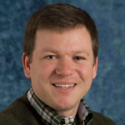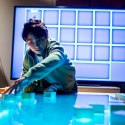UW physicist works with young Rube Goldbergs at Madison elementary school
Kindergartener Odin Porshot and his father, Caleb, concoct a “Rube Goldberg” contraption at Family Science Night at Emerson School. The winner will be the most complicated and ridiculous device that can ring a bell.
Photo: David Tenenbaum
The rules are simple, explains Mike Randall, a UW–Madison physicist, who is leading the Rube Goldberg lab tonight at Emerson School in Madison. “Make a contraption that starts by dropping a marble and ends by ringing a bell.”
The students have a half hour to make their contraptions; then Randall starts judging the results. “The more ridiculous, the better,” he says.
It’s Family Science Night at Emerson, and elementary school students from about 115 families are crowded with their parents in a classroom, huddling over the pegboard armature for the Rube Goldberg Lab. Goldberg was a cartoonist who dreamed up fascinating but useless gadgets that functioned in the most arcane, redundant and amusing way possible.
The lab is a great way to painlessly demonstrate some principles of physics — gravity, motion, momentum, energy — says Randall, who is the outreach coordinator for Wonders of Physics at the UW. That long series of demonstrations was pioneered 30 years ago by UW–Madison Professor of Physics Clint Sprott.
“I think the education is secondary to the inspiration. It’s about having people get excited about how the world works, be curious so they want dig into it and learn more on their own.”
Mike Randall
Wonders is not only going strong; it’s expanding, Randall says, with plans to establish satellite programs at other UW campuses. In the 12 months ending June 30, Randall expects Wonders to have reached more than 35,000 people through annual campus presentations, traveling shows in Wisconsin and across the U.S., TV appearances, summer camps, science festivals and other outreach events.
Physics is about our daily existence, and Wonders makes that connection in a compelling way, Randall says. For the show, he says, excitement is more central than absorbing facts. “I think the education is secondary to the inspiration. It’s about having people get excited about how the world works, be curious so they want dig into it and learn more on their own.”
Wonders of Physics does have an entertainment element, and at an April performance at Engineering Expo on the UW–Madison campus, Randall presided over a tableful of fun. To demonstrate Newton’s laws of motion, he used a turntable, bicycle wheel and medicine ball. To demonstrate pressure, he used an air cannon.
Randall was in his element, cajoling a standing-room-only auditorium of high-schoolers to answer questions and volunteer for stage demonstrations. “People do learn about physics, but it’s more about getting their minds to open up, getting them to think about the world from a different perspective,” he says after the show.
“In general, if you say ‘physics,’ people are going to think it’s hard, boring, has nothing to do with me. We are trying to show that nothing is further from the truth. It’s fun, accessible, we use physics all the time — we just don’t know we are using it,” Randall says.
“In general, if you say ’physics,’ people are going to think it’s hard, boring, has nothing to do with me. We are trying to show that nothing is further from the truth.”
Mike Randall
Back at Emerson, it’s controlled chaos as the students confront the challenge of joining plastic gutters, tape, string, spools, dowels and mousetraps into a workable — but yes, ridiculous — contraption. After 20 minutes, a few bells are heard ringing and soon, it’s time for Randall to start the judging.
Here, Randall becomes a “strict constructionist.”
“Each useful part gets one point,” he tells the class. “If I don’t think your parts are doing something useful, they won’t count unless you can show me that they really are functional.”
But no matter how few elements the student has included, this one-time “rocket scientist” offers encouragement. “You listened to the rules, you used these parts successfully,” he tells more than one student.
How does Randall know the Rube Goldberg Lab is working? “Kids eat it up, they get really absorbed, it’s fun and engaging. It gets their creativity going, gets them playing with simple machines and using the scientific method — the process of coming up with an idea, building something and testing, observing what happens, modifying the design and going back in a cyclic process to get something to work.”
Although he presents no such lengthy explanations of scientific method, Randall does encourage the students to watch each other. “Scientists do this all the time,” he points out. “They look at what other scientists are doing and learn from them.”
As intended, tonight’s impact comes more from doing than explaining, Randall says. “They were just having fun, none of this shows up on their radar.”



